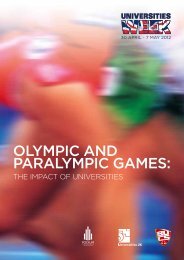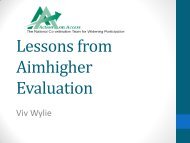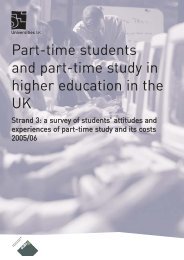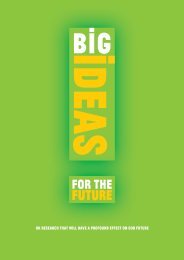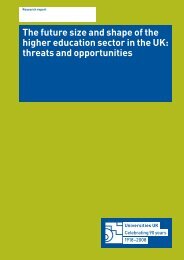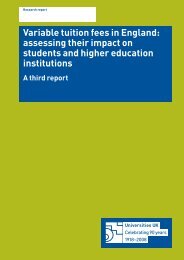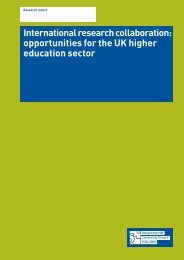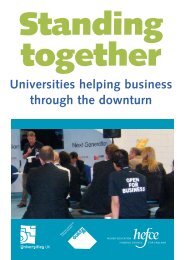Creating Prosperity: the role of higher education in ... - Universities UK
Creating Prosperity: the role of higher education in ... - Universities UK
Creating Prosperity: the role of higher education in ... - Universities UK
Create successful ePaper yourself
Turn your PDF publications into a flip-book with our unique Google optimized e-Paper software.
<strong>Creat<strong>in</strong>g</strong> <strong>Prosperity</strong>: <strong>the</strong> <strong>role</strong> <strong>of</strong> <strong>higher</strong> <strong>education</strong><strong>in</strong> driv<strong>in</strong>g <strong>the</strong> <strong>UK</strong>’s creative economy113.16 This raises <strong>the</strong> issue <strong>of</strong> how to measure <strong>in</strong>novation <strong>in</strong> <strong>the</strong> creative sector. Certa<strong>in</strong>ly, traditionalmeasures <strong>of</strong> research and development (R&D) and <strong>in</strong>novation fail to capture adequately s<strong>of</strong>t<strong>in</strong>novation, or <strong>in</strong>deed bus<strong>in</strong>ess model <strong>in</strong>novation. R&D and patent measures focus on science andtechnology <strong>in</strong>novation, and do not take account <strong>of</strong> aes<strong>the</strong>tic <strong>in</strong>novation. Instead, <strong>in</strong>dicators such astrademarks, copyright and registered designs are more relevant, even if <strong>the</strong>y are not always widelyused as a means <strong>of</strong> protect<strong>in</strong>g <strong>in</strong>tellectual property. More recently, NESTA’s work on a new InnovationIndex has made a useful contribution to th<strong>in</strong>k<strong>in</strong>g about <strong>in</strong>novation measurement, captur<strong>in</strong>g <strong>the</strong>sebroader <strong>in</strong>novation concepts, and may <strong>of</strong>fer some future potential (NESTA, 2009).The process <strong>of</strong> <strong>in</strong>novation3.17 Evidence suggests that <strong>the</strong> <strong>in</strong>novation process <strong>in</strong> creative <strong>in</strong>dustries differs fundamentally fromtraditional l<strong>in</strong>ear models <strong>of</strong> <strong>in</strong>novation <strong>in</strong> science – it is open, iterative and collaborative, work<strong>in</strong>gthrough networks and up and down supply cha<strong>in</strong>s <strong>in</strong> ways that are nei<strong>the</strong>r well researchednor understood.3.18 The small scale <strong>of</strong> creative enterprises, <strong>the</strong> natural (creative) tendency to look for multipleperspectives and <strong>the</strong> grow<strong>in</strong>g demands <strong>of</strong> fast-chang<strong>in</strong>g technology make open and collaborativemodels <strong>of</strong> <strong>in</strong>novation a necessary part <strong>of</strong> <strong>the</strong> bus<strong>in</strong>ess process <strong>in</strong> <strong>the</strong> creative <strong>in</strong>dustries.3.19 Such models are pervasive across <strong>the</strong> creative <strong>in</strong>dustries, with strong growth <strong>in</strong> co-production andnetwork-based activity. The <strong>in</strong>creas<strong>in</strong>g shift onl<strong>in</strong>e, and towards cross-platform and <strong>in</strong>teractive media,is likely to lead to cont<strong>in</strong>ued growth <strong>in</strong> collaboration between content creators, technology providersand distributors. This collaborative and networked approach places great emphasis on social andmanagement skills, partnerships and networks.3.20 Innovation support, however, especially for university-bus<strong>in</strong>ess <strong>in</strong>teractions, has failed to keeppace with advances <strong>in</strong> policy th<strong>in</strong>k<strong>in</strong>g, and still focuses on a l<strong>in</strong>ear, technology-driven model ra<strong>the</strong>rthan collaborative, <strong>in</strong>teractive approaches. As a result, many creative bus<strong>in</strong>esses view <strong>the</strong> supportstructures as not relevant.3.21 Research also suggests that <strong>in</strong>novation processes are not widely recognised as such with<strong>in</strong> <strong>the</strong>creative <strong>in</strong>dustries, and are just seen as an <strong>in</strong>tegral part <strong>of</strong> bus<strong>in</strong>ess activity (Miles and Green, 2008).Even <strong>in</strong> more technology-based sectors such as games, formal R&D is limited, and failure to accountfor <strong>the</strong> resources allocated to R&D work (for example on new tools) has restricted <strong>the</strong> <strong>in</strong>dustry’saccess to R&D tax credits. This is despite considerable efforts on <strong>the</strong> part <strong>of</strong> trade associationsto promote this opportunity.3.22 The difficulty here is <strong>in</strong> <strong>the</strong> demarcation <strong>of</strong> <strong>in</strong>novation-related processes from core creative productionactivities. Innovation is more <strong>of</strong>ten <strong>in</strong>tegrated <strong>in</strong>to <strong>the</strong> bus<strong>in</strong>ess <strong>of</strong> creative enterprises, and can be anongo<strong>in</strong>g feature <strong>of</strong> projects (for example <strong>the</strong> revision <strong>of</strong> tools throughout <strong>the</strong> development <strong>of</strong> a gameor repackag<strong>in</strong>g broadcast content for onl<strong>in</strong>e or mobile platforms).3.23 The multidiscipl<strong>in</strong>ary nature <strong>of</strong> <strong>in</strong>novation <strong>in</strong> <strong>the</strong> creative economy is such that valuable academic<strong>in</strong>put could come from a very wide range <strong>of</strong> discipl<strong>in</strong>es, from creative arts to computer science,bus<strong>in</strong>ess and social sciences. The iterative and collaborative nature <strong>of</strong> <strong>the</strong> <strong>in</strong>novation process alsoargues for new models <strong>of</strong> engagement between <strong>in</strong>dustry and <strong>higher</strong> <strong>education</strong> that move far beyondtraditional technology transfer approaches and that comb<strong>in</strong>e <strong>in</strong>put from a range <strong>of</strong> areas <strong>in</strong> amore fluid way.3.0 Drivers <strong>of</strong> <strong>the</strong> creative economy



